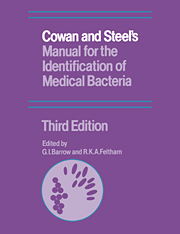Book contents
- Frontmatter
- Contents
- Foreword
- Preface to the first edition
- Postscript
- Preface to the second edition
- Preface to the third edition
- List of contributors
- Introduction
- 1 Classification and nomenclature
- 2 Culture media: constituents and sterilization
- 3 Principles of isolation
- 4 Bacterial characters and characterization
- 5 Theory and practice of bacterial identification
- 6 Characters of Gram-positive bacteria
- 7 Characters of Gram-negative bacteria
- 8 Taxonomy in theory and practice
- 9 Bacterial identification by cards
- 10 Bacterial identification by computer
- 11 Quality control in microbiology
- Appendices
- References
- Index
4 - Bacterial characters and characterization
Published online by Cambridge University Press: 15 December 2009
- Frontmatter
- Contents
- Foreword
- Preface to the first edition
- Postscript
- Preface to the second edition
- Preface to the third edition
- List of contributors
- Introduction
- 1 Classification and nomenclature
- 2 Culture media: constituents and sterilization
- 3 Principles of isolation
- 4 Bacterial characters and characterization
- 5 Theory and practice of bacterial identification
- 6 Characters of Gram-positive bacteria
- 7 Characters of Gram-negative bacteria
- 8 Taxonomy in theory and practice
- 9 Bacterial identification by cards
- 10 Bacterial identification by computer
- 11 Quality control in microbiology
- Appendices
- References
- Index
Summary
Features such as brightly coloured pigments may be characteristic of a few species as well as a good pointer to the nature of the organism and its ultimate identification. But pigments may mislead, as in the Biblical case of bleeding polenta which is no longer considered to be a miracle but a phenomenon that can be produced experimentally by a bacterium and in nature is commonly produced by a yeast (Merlino, 1924; Gaughran, 1969; Cowan, 1956a, 1910b). As bacteria present few gross diagnostic features they must be looked at closely; the characters sought and the tests applied will depend on knowledge and expertise as well as experience with similar organisms; the approach to identification will be conditioned by professional training and intuitive skill. The observations made and the tests applied are aimed at characterizing the organism so that it can be described (the technical term for the list of characters is a description) and compared with descriptions of other, previously identified and classified organisms.
Bacterial characterization
The difference between characterization for classification and for identification lies not so much in the tests themselves as in the emphasis placed on the results of the tests. Although it is not universally accepted, most taxonomists now support the Adansonian concept that, for classification, equal weight should be given to each character or feature.
- Type
- Chapter
- Information
- Publisher: Cambridge University PressPrint publication year: 1993
- 10
- Cited by



